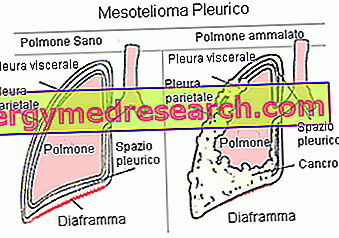Pleural tumor
Pleural cancer is a severe and potentially fatal form of cancer that affects the pleura, the double serous membrane that covers and supports the lungs in the thoracic cavity. More precisely, we speak of pleural mesothelioma when the tumor exclusively affects the mesothelium (epithelium that envelops all the large serous cavities such as the pleural cavity).

Let us briefly recall that the pleural variant is the most common form of cancer among the three types of mesothelioma: over 75% of mesotheliomas are diagnosed at the level of the pleura.
Let's see in more detail which are the most common tumors affecting the pleura.
Pleural tumors can be divided into 4 sub-categories:
- Malignant pleural mesothelioma
- Solitary fibrous tumor of the pleura
- Secondary neoplasms (to other tumors)
- Lymphomas
In this article the focus will be on the study of malignant pleural mesothelioma - the most common malignant tumor originating from the pleura - and of the solitary fibrous tumor of the pleura.
Pleural mesothelioma
As analyzed, pleural mesothelioma is a widespread form of cancer that affects the pleural mesothelium. Primary tumors of the pleura appear to arise following repeated exposure to a very limited number of exogenous agents: asbestos (or asbestos) and its derivatives. However, the above does not exempt from the possibility that other factors may intervene in the etiopathogenesis of this neoplasm. In fact, other predisposing elements are also involved, such as genetic alterations and previous infections supported by the SV40 virus ( Simian vacuolating virus 40 or Simian virus 40 ).
CAUSES
Exposure to asbestos fibers appears to increase the risk of developing lung cancer by 5 times. The asbestos fibers, which have reached the lungs, are literally incorporated into the pleura; subsequently, the material travels in extra-pulmonary locations up to the ribs. Already in the initial stage, the tumor masses can involve both the serous leaflets that make up the pleura, even if the parietal membrane seems to be more affected than the visceral one.
SYMPTOMS
To learn more: Symptoms of Pleural Mesothelioma
Asbestos fibers, reached in the lung, can cause an immediate inflammation of the pleura (pleuritis), thus causing stabbing chest pain and dyspnea. In other cases, asbestos fibers create a pleural tumor after a fairly long time, triggering the first symptoms after some years (usually after 3 years).
Spy lit by pleural mesothelioma is the neoplastic pleural effusion, felt by the patient as an abnormal pain in the chest, which is accentuated with coughing and deep breathing.
Note the particular speed with which a pleural tumor of this type advances: the growth of diseased cells is in fact surprisingly rapid. In a short time the tumor can cover the entire pulmonary cavity, making breathing very painful. In advanced stages, the tumor also spreads to nearby organs, such as the heart, lymph nodes and abdomen.
In addition to excruciating pain during breathing, other symptoms may indicate to the patient that something in the body is not functioning properly:
- Blood clots
- Language difficulty
- Breathing difficulties
- Shortness of breath
- lack of appetite
- Unwanted weight loss
- Hoarseness
- Possibly bleeding pleural effusion (hemothorax)
DIAGNOSIS
From the analysis of a sample of pleural fluid obtained by thoracentesis it is possible to diagnose the pleural tumor: the anomalous cellular composition, in fact, can ascertain the diagnosis. Furthermore, the liquid taken is dense and stringy due to the abnormal amount of hyaluronic acid developed.
Thoracentesis must be preceded by a screening test (RX or TC). VATS ( Video Assisted Thoracic Surgery ) pleural biopsy and thoracotomy may also be other indicated diagnostic options.
THERAPY
Unfortunately, pleural mesothelioma is a malignant form of particularly aggressive cancer. Therapy is almost ineffective in the vast majority of affected patients. However, the cancer patient is almost always treated with radiation therapy combined with chemotherapy. When possible, surgery is also used which consists of removing the tumor mass.
Many patients die 6-7 months after the onset of this pleural cancer.
Solitary fibrous tumor of the pleura
Rare normally benign neoplasm, the solitary fibrous tumor of the pleura derives from the mesenchymal cells of the subpleural connective tissue. This neoplastic form affects both serous leaflets constituting the pleura (visceral and parietal); only rarely does the cancer also involve mediastinum, pancreas, neck, paranasal sinuses and lung.
The solitary fibrous tumor of the pleura can ideally afflict men and women of every race and age. However, it has been observed that most of these tumors affect the over-60s.
The solitary fibrous tumor of the pleura has a much lower incidence than pleural mesothelioma.
SYMPTOMS
This pleural tumor variant has a mostly silent course. Not surprisingly, cancer is often diagnosed by chance through a simple imaging test.
When symptomatic, the patient is documented mainly related to the structural extension of the neoplastic mass to nearby anatomical structures. In this case, the higher the mass, the more marked the symptoms: dyspnoea, chest pain and cough are three very recurrent symptoms in cancer patients suffering from pleural fibrous tumor. Less frequently, on the other hand, the patient suffering from this form of pleural cancer complains of anorexia, chills, fever, hemoptysis, swelling of the lower limbs, paraneoplastic manifestations (hyper-production of insulin-like growth factor II), syncope and effusion pleural. In giant forms, it is possible to find hypomobility of the hemithorax involved in the neoplasm.
DIAGNOSIS
As mentioned, the pleural fibrous tumor is often diagnosed by chance, through a simple radiological investigation performed for other reasons. Among the other diagnostic strategies aimed at ascertaining pleural cancer, we mention: routine hematologic examinations, upper abdomen echotomography, CT, thoracic CT and MRI. Some patients undergo a further diagnostic test, known as PET or Positron Emission Tomography, useful in some selected subjects where a malignant tumor degeneration is suspected.
THERAPY
The treatment to remove this pleural tumor is surgical: all the tumor mass must be removed, with possible excision of one or more portions of the parietal / diaphragmatic / mediastinal pleura. Neither radiation therapy nor chemotherapy are first choice treatment therapies (clearly in the absence of malignant tumor cells).
What to know
The key concepts of the solitary fibrous tumor of the pleura are reported in the table.
Aetiology | Unknown. There is no correlation demonstrated with smoke or asbestos dust |
Tumor structure | Fibrous solid mass varying in size from 5 to 20 cm |
Tumor target | Visceral and parietal pleura (most frequently) |
Prognosis | Favorable in most cases (following surgical excision). Poor prognosis in 12-33% of patients |
Histological analysis | Spreading cells Round-oval cell nucleus Chromatin distribution: regular Cytoplasm: eosinophilic Presence of collagen mixed with cancer cells |
Symptoms | The solitary fibrous tumor of the pleura is almost always asymptomatic. In the advanced stage there is a particular compression symptomatology, accompanied by dyspnea, pain and cough. Possible anorexia, night sweats, swelling of the lower limbs, hypoglycemia, osteoarthropathy and fever |
In most cases, the solitary fibrous tumor of the pleura is benign, although sometimes there are signs of histological malignancy. After surgery, the prognosis is generally excellent.



